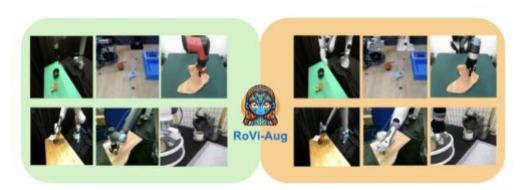Researchers at UC Berkeley have developed RoVi-Aug, a computational framework that augments robotic data, enabling easier skill transfer between different robots.
In recent years, roboticists have created a variety of systems aimed at performing real-world tasks, from household chores to package delivery and locating specific objects in controlled environments. A major goal in this field is to develop algorithms that enable the transfer of specific skills across robots with varying physical characteristics, facilitating quick training on new tasks and expanding their functional capabilities.
Researchers at UC Berkeley have introduced RoVi-Aug, a novel computational framework that augments robotic data to streamline the transfer of skills between different robots. This process generates synthesized visual task demonstrations from multiple camera perspectives for various robots, facilitating easier skill transfer.
The researchers discovered that many prominent robot training datasets, including the widely-used Open-X Embodiment (OXE) dataset, are unbalanced. The OXE dataset, known for its diverse demonstrations of different robots performing various tasks, tends to feature a disproportionate amount of data for certain robots, like the Franka and xArm manipulators, compared to others.
The new robot data augmentation framework developed by the researchers, RoVi-Aug, leverages advanced diffusion models. These computational models are capable of augmenting images of a robot’s trajectories to generate synthetic images. These images depict different robots performing tasks from various viewpoints, enhancing the framework’s utility for diverse robotic applications.
The researchers utilized their framework, RoVi-Aug, to create a dataset filled with a variety of synthetic robot demonstrations. They then used this dataset to train robot policies that enable the transfer of skills to new robots through zero-shot learning, where the robots learn tasks they have not previously encountered. Notably, these robot policies are also capable of fine-tuning for progressively improved task performance. In contrast to the Mirage model from their previous research, their new algorithm can accommodate significant changes in camera angles.
Collecting large amounts of real-world robot demonstrations can be costly and time-consuming, making RoVi-Aug a cost-effective alternative for compiling reliable robot training datasets quickly. Although the images in these datasets are synthetic, generated by AI, they can still be effective in producing reliable robot policies.
Reference: Lawrence Yunliang Chen et al, RoVi-Aug: Robot and Viewpoint Augmentation for Cross-Embodiment Robot Learning, arXiv (2024). DOI: 10.48550/arxiv.2409.03403
Original article source:
https://www.electronicsforu.com/news/new-algorithm-may-ease-skill-transfer-between-robots
FAQ
1. What is skill transfer between robots?
Skill transfer refers to the ability of one robot to “teach” or pass on learned tasks or capabilities to another robot. This typically involves transferring data, behaviors, or control policies that allow the second robot to perform a similar task with minimal reprogramming or retraining.
2. How does the new algorithm improve skill transfer between robots?
The new algorithm is designed to enhance the ability of robots to share and adapt skills across different platforms or environments. It does this by leveraging machine learning techniques that generalize learned tasks, reducing the need for manual intervention and reprogramming. The algorithm can analyze variations between robots, such as hardware differences, and make adjustments to optimize performance.
3. What types of tasks can be transferred between robots?
Tasks that can be transferred between robots using these algorithms range from basic manipulation tasks, like picking and placing objects, to more complex activities, such as navigation, object recognition, and even collaborative tasks that involve multiple robots working together.
4. Does the new algorithm work for different types of robots?
Yes, the algorithm is designed to be flexible across different robotic platforms. This means it can accommodate various types of robots, from industrial arms to autonomous vehicles, allowing them to transfer skills regardless of differences in their sensors, actuators, or physical design.
5. How does this benefit industries using robotics?
Industries benefit by reducing the time and cost associated with programming robots for new tasks. With this algorithm, companies can deploy robots more quickly and allow them to adapt to new roles with minimal human input. This improves efficiency in areas like manufacturing, logistics, healthcare, and more.
6. What challenges does the algorithm overcome?
The primary challenges in skill transfer are differences in robot hardware, variations in sensor data, and the complexity of adapting skills to new environments. This algorithm addresses these by creating a framework that allows robots to share a skill “template” and modify it according to their individual characteristics and the specific task environment.
7. Is this technology ready for commercial use?
While still in development and testing, this type of algorithm shows great promise for future commercial applications. Some companies and research labs are already experimenting with early versions of these algorithms in controlled environments, but widespread implementation will likely come after further refinement.
